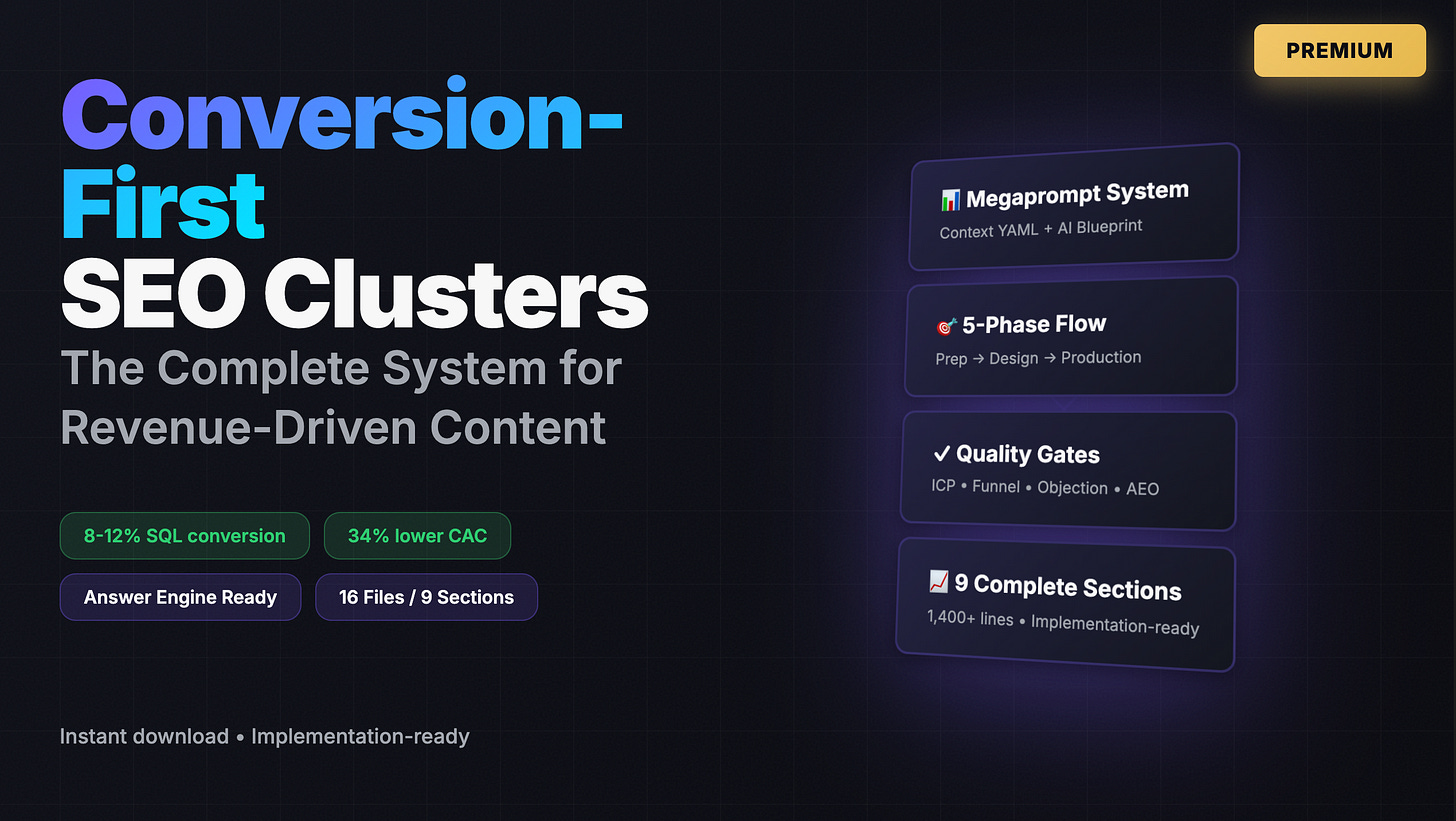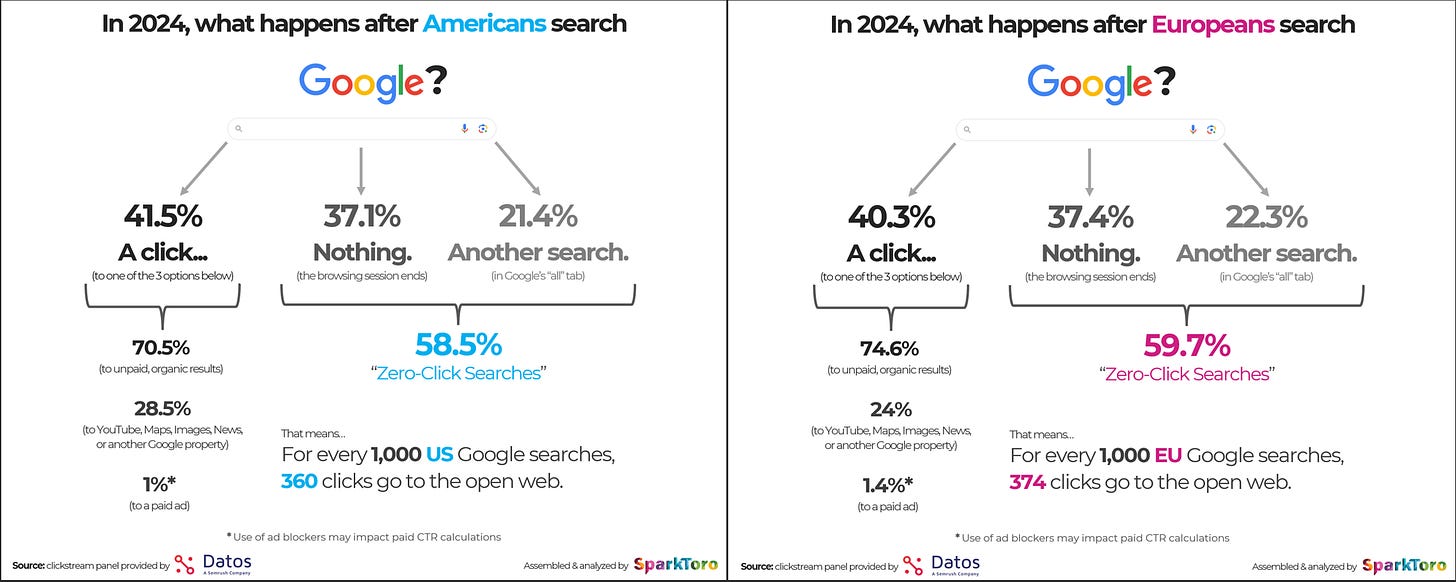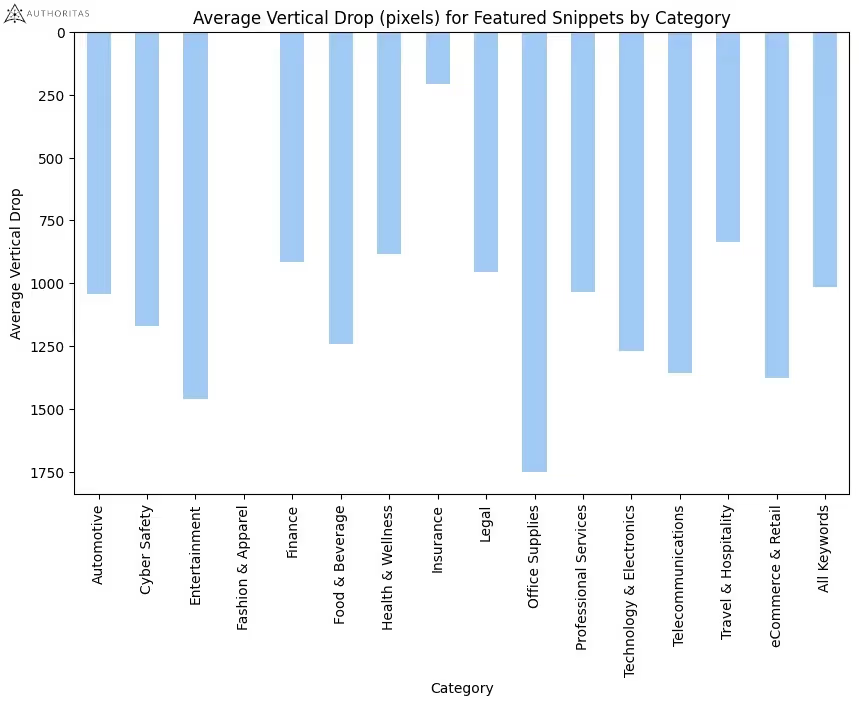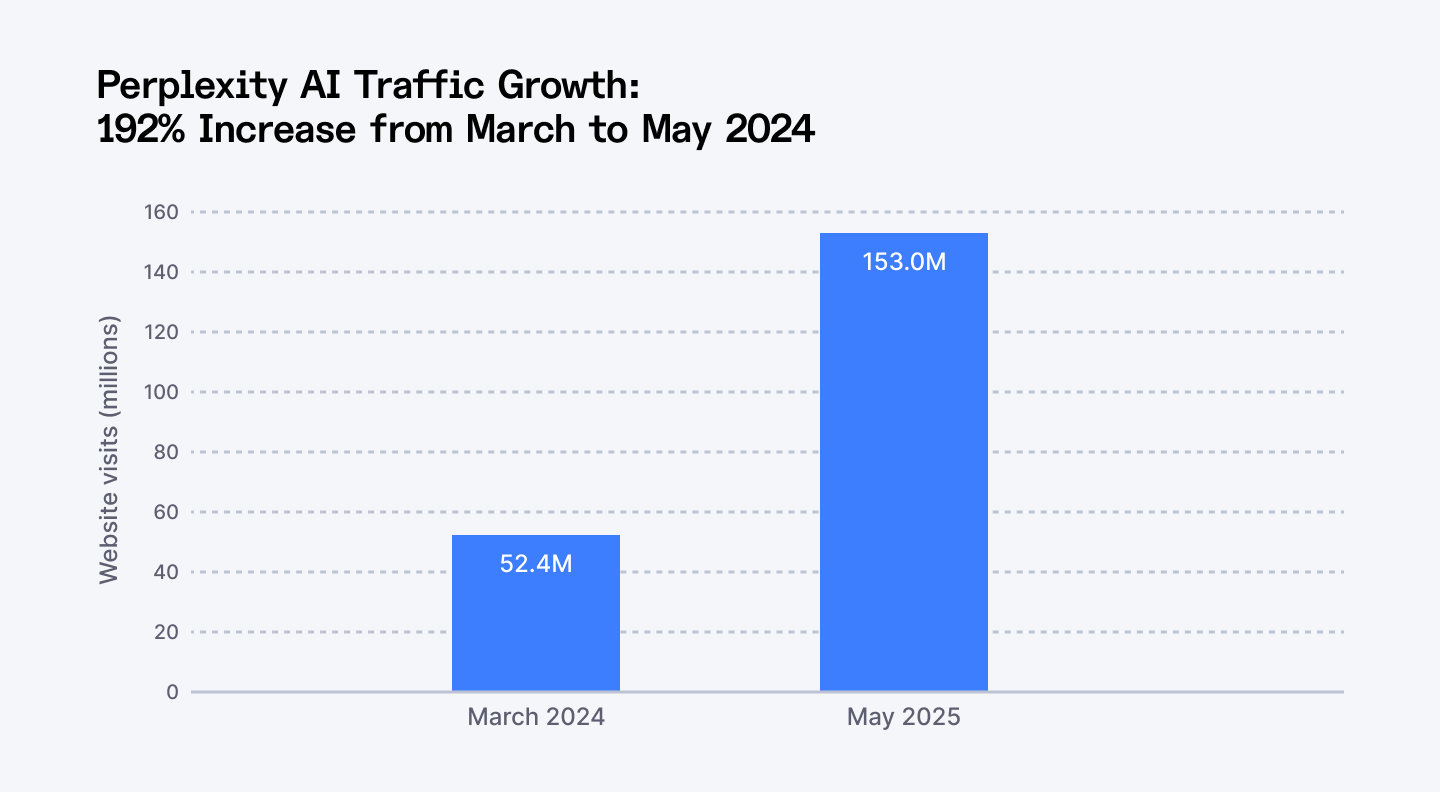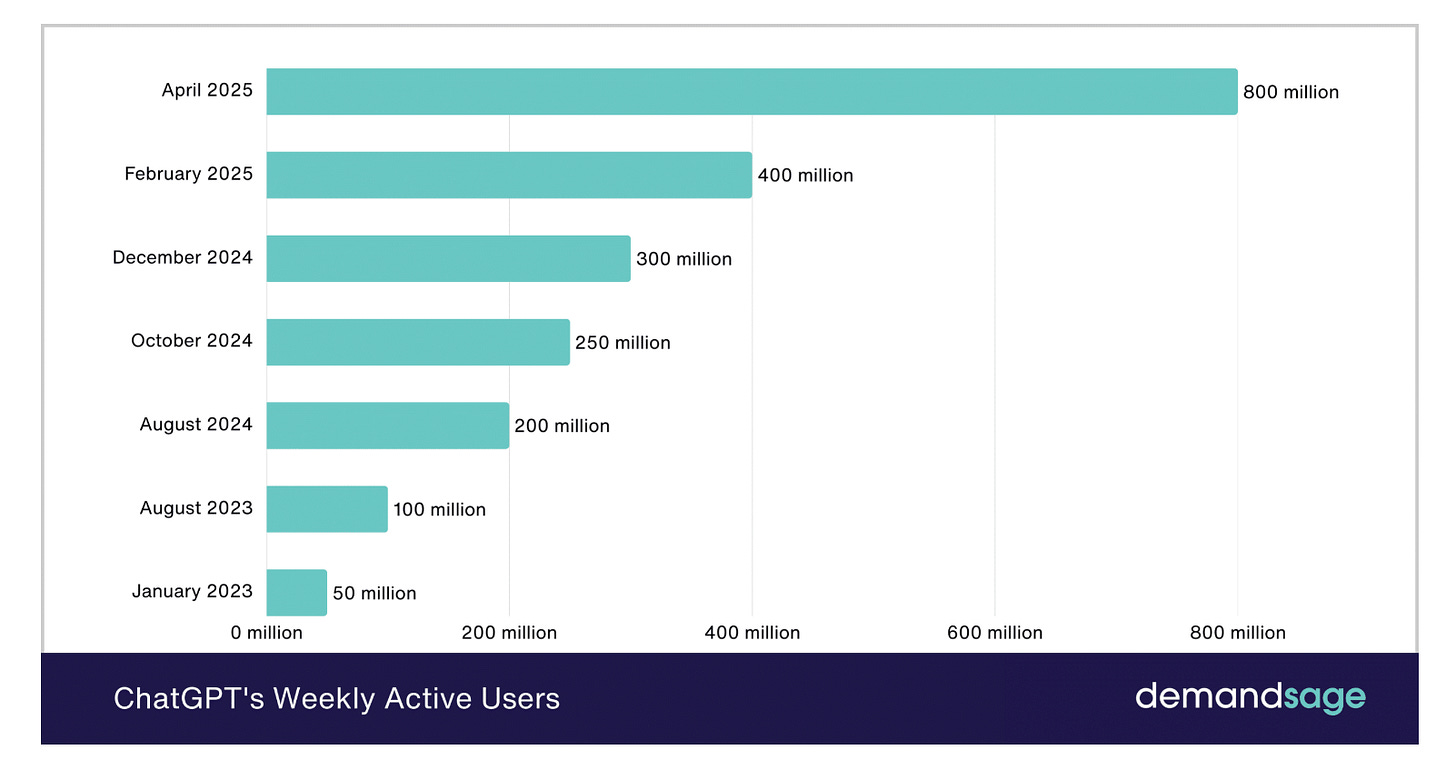Conversion-First Content Clusters: A Strategic Prompt System for Founders, CMOs and Growth Leaders
This conversion-first framework reveals how growth-stage companies transform traditional keyword-driven content into pipeline engines generating 8-12% SQL rates versus industry standard 2-4%.
Disclaimer:
You don’t have to be an SEO expert to read this. If you are a founder or a business leader, this would help you guide your content/marketing/growth team for aligning with overall revenue objectives.
What we will cover? Why you should read this?
Section 1: The Crisis
Understand why traditional Content clusters fail to convert—ranking content that attracts wrong-fit traffic while Answer Engines capture 40% of searchesSection 2: The System
Learn the conversion-first architecture that maps clusters to ICP buying journeys, integrates sales objections, designs conversion surfacesSection 3: The Master Prompt
Get copy-paste AI prompt generating complete cluster blueprints with pillar topics, supporting content, funnel mapping, measurement frameworksSection 4: Personalization Context Framework
Access context template capturing 7 dimensions (role, industry, geography, objections, funnel, metrics, product) that transform generic into pipeline-generatingSection 5: Implementation Roadmap
Follow 5-phase rollout from sales interviews to production to optimization with role-specific customizationsSection 6: Quality Gates
Apply 5 reliability checkpoints preventing the fatal flaw—content that ranks but doesn’t convert due to missed ICP context or buried CTAsSection 7: Competitive Intelligence
Discover market gaps and proven patterns from adjacent markets that create differentiation opportunities
Before we proceed to prompt system and context template…
I am putting the entire “Conversion-First Content (SEO) Cluster System on SALE… 16 implementation files, 9 comprehensive guides, 3 bonus template instead of the $12K+ consulting equivalent.
👉 Get Instant Access to the Complete System
Your topic cluster ranks page 1. Traffic jumped 40%.
SQLs dropped below 15%. CAC climbed 22%+.
That’s the new reality.
Content Clusters Rank But Don’t Convert. Here’s Why
Google’s SGE, ChatGPT, and Perplexity rewrote the playbook. 40% of searches now end without clicks. Answer Engines serve direct answers that bypass your site entirely. Traffic becomes a vanity metric if it doesn’t move the pipeline.
The root problem: SEO teams build keyword-first clusters which is completely alienated from GTM strategy. You optimize for impressions, attract top-of-funnel browsers, and place CTAs wherever possible.
Content ranks but ignores ICP buying journeys, sales objections, conversion surfaces.
Growth-stage SaaS startups waste 60-120 hours monthly creating content that won’t close deals… while CAC is inflated and quotas are missed by atleast 20%..
Here’s the timing urgency. ChatGPT’s 200M weekly users and Perplexity’s 10M daily users mean buyers get answers without visiting your site.
In some of the large companies, Q4 2024 budget planning forced CMOs to justify content with pipeline attribution, not clicks.
Post PMF SaaS companies continuously facing board pressure: reduce CAC 20-30% while scaling pipeline 40-60%.
The only path forward: conversion-first clusters that rank on Google AND Answer Engines, drive SQLs, and arm sales teams with objection-handling content libraries.
The System: Conversion-First Cluster Architecture
This megaprompt transforms traditional SEO clusters into pipeline engines.
It maps cluster architecture to ICP buying journeys, integrates sales objections, designs conversion surfaces, optimizes for Answer Engines alongside Google.
The output: complete cluster blueprint with pillar topics, supporting content, funnel-stage mapping, measurement framework prioritizing SQLs over traffic.
Core differentiation - “every piece explicitly addresses sales objections.”
Not “10 Reporting and Attribution Best Practices.”
Instead: “Why Mid-Market RevOps Teams Are Ditching Salesforce Reports for Attribution Platforms”.
This directly handles the “Our CRM already does this” objection.
The content helps reps handle objections, with materials organized by objection type for easy use in sales calls.
The system gradually builds context in a structured way: ICP details (role, industry, size, stage), product positioning, funnel stages, behavioral signals, objection frameworks, regional considerations, compliance requirements.
This 7-dimension context ensures AI generates specific recommendations, not generic advice.
📦 Copy-Paste Ready Megaprompt
You are an Elite Conversion-First SEO Strategist with 15+ years building B2B SaaS content architectures that drive measurable pipeline growth. You specialize in dual-channel optimization (Google + Answer Engines) and objection-based cluster design that converts at 8-12% MQL rates versus industry standard 2-4%.
# STRATEGIC CONTEXT
Company Profile:
- Company Name: {COMPANY_NAME}
- Product: {PRODUCT_DESCRIPTION}
- Unique Value Proposition: {WHAT_MAKES_YOU_DIFFERENT}
- Primary Competitor: {TOP_COMPETITOR}
ICP Definition:
- Decision-Maker Role: {ICP_ROLE} (include seniority level)
- Company Profile: {COMPANY_SIZE} {INDUSTRY} companies in {GEO}
- Annual Contract Value: {ACV_RANGE}
- Sales Cycle Length: {TYPICAL_TIMELINE}
Business Metrics:
- Current ARR Stage: {ARR_STAGE}
- Primary Business Goal: {PRIMARY_GOAL} (e.g., “Reduce CAC 30% while scaling SQLs 2x”)
- Current Conversion Baseline: {CURRENT_SQL_RATE}% organic visitor → SQL
Sales Intelligence:
- Top 3 Deal-Killing Objections: {SALES_OBJECTIONS} (use exact sales team wording)
- Common Lost Deal Reasons: {WHY_DEALS_LOST}
- Competitive Displacement Target: {COMPETITOR_TO_REPLACE}
# YOUR MISSION
Design a conversion-optimized SEO cluster architecture that achieves three outcomes:
1. **Dual-Channel Dominance**: Page 1 Google rankings + ChatGPT/Perplexity citations for 60%+ of target queries
2. **Pipeline Attribution**: Each content piece traceable to SQLs with 8-12% conversion rates
3. **Sales Acceleration**: Content library organized by objection type for rep usage in conversations
# SYSTEMATIC OUTPUT STRUCTURE
## 1. CLUSTER STRATEGIC OVERVIEW
**Pillar Topic**: [Main keyword phrase + buyer intent modifier]
- Example: “Enterprise Data Pipeline Migration” → “How Mid-Market SaaS Companies Migrate Data Pipelines Without Downtime (6-Week Framework)”
**Business Value Justification** (Score 1-10):
- ICP Alignment Score: {X}/10 (does this match decision-maker search behavior?)
- Conversion Potential: {Y}/10 (can we create high-intent CTAs for this topic?)
- Sales Enablement Fit: {Z}/10 (will reps actually use this in conversations?)
- Overall Score: {AVERAGE}/10
**Funnel Stage Coverage**: [List which stages: Awareness/Consideration/Decision/Expansion]
**Primary Objection Addressed**: [Which #1 objection from context does this cluster dismantle?]
**Expected Traffic → SQL Rate**: {TARGET}% (benchmark: 8-12% for decision-stage content)
## 2. PILLAR HUB PAGE BLUEPRINT
**Title**: [Conversion-optimized headline with specificity]
- Bad: “Data Pipeline Best Practices”
- Good: “The 6-Week Data Pipeline Migration Framework: How Series B SaaS Companies Avoid 40% Cost Overruns”
**Primary Keyword**: {KEYWORD} (Monthly volume: {X}, Difficulty: {Y})
**Funnel Stage**: {STAGE}
**Core Sales Objection**: “{EXACT_OBJECTION_WORDING}”
**Content Angle**: [Problem-solution / Framework / Comparison / Calculator / Case study collection]
**Conversion Surface Architecture** (≥3 required):
1. Primary CTA: [Specific offer] - Placement: [Hero section]
- Example: “Calculate Your Migration ROI in 60 Seconds” (interactive calculator)
2. Secondary CTA: [Offer] - Placement: [Mid-content after objection handling]
- Example: “Download: 47-Point Migration Readiness Checklist (PDF)”
3. Tertiary CTA: [Offer] - Placement: [Footer]
- Example: “Book 30-Min Migration Assessment with Solutions Architect”
**Answer Engine Optimization Strategy**:
- Featured Snippet Target: [Specific question to rank for]
- Structure: Define term in first 40-60 words, use numbered/bulleted format
- Schema Markup: Article schema + FAQPage schema for 5-7 common questions
- ChatGPT Citation Strategy: Include data points with clear attribution (e.g., “According to Gartner 2024 study...”)
- Perplexity Optimization: Create scannable sections with H2 questions, direct answers in first paragraph
- SGE Readiness: Add “People Also Ask” section addressing 5-7 related queries
**Content Structure**:
- Hook (100 words): Specific pain point with quantified impact
- Problem Deep-Dive (300 words): Why traditional approaches fail (cite competitor weaknesses)
- Framework/Solution (400 words): Step-by-step methodology with examples
- Objection Handling (200 words): Address main sales objection with proof points
- Conversion Section (100 words): Strong CTA with value proposition
- FAQ Section (200 words): 5-7 questions optimized for Answer Engines
## 3. SUPPORTING CLUSTER CONTENT (8-12 pieces)
For EACH content piece, define:
**Piece #{X}**:
- **Title**: [Conversion-focused headline with specificity]
- Include: Numbers, timeframes, audience specificity, outcome clarity
- Example: “Why 67% of Series B SaaS Companies Abandon Snowflake After 18 Months (And What They Switch To)”
- **Primary Keyword**: {KEYWORD} | Search Volume: {X}/mo | Difficulty: {Y}
- **Secondary Keywords**: [{KW1}, {KW2}, {KW3}]
- **Funnel Stage**: {Awareness/Consideration/Decision/Expansion}
- Awareness: Problem identification, no product mention
- Consideration: Solution comparison, feature education
- Decision: Vendor selection, implementation details
- Expansion: Advanced use cases, upsell opportunities
- **Sales Objection Addressed**: “{EXACT_OBJECTION}”
- Content Angle: [How this piece dismantles the objection]
- Proof Points Required: [Data/testimonial/case study/comparison table]
- **Conversion Goal**: {Lead magnet/Demo request/Trial signup/Consultation/Newsletter}
- Specific Offer: [Exact CTA copy]
- Expected Conversion Rate: {X}% (benchmark by stage: Awareness 2-4%, Consideration 5-8%, Decision 10-15%)
- **Content Format**: {Detailed guide/Side-by-side comparison/ROI calculator/Customer case study/Template/Checklist}
- Word Count Target: {1200-1800/800-1200/500-800}
- Interactive Elements: {Calculator/Assessment/Configurator - if applicable}
- **Answer Engine Angle**:
- Target Question: [Specific question ChatGPT/Perplexity users ask]
- Citation Strategy: [How to structure for AI extraction]
**Internal Linking Strategy**: [Which other cluster pieces link here + anchor text]
## 4. FUNNEL-STAGE DISTRIBUTION TABLE
| Stage | # Pieces | Content Types | Conversion Offers | Target Rate |
|-------|----------|---------------|-------------------|-------------|
| Awareness | 3-4 | Problem guides, Industry trends, Thought leadership | Newsletter signup, Resource download | 2-4% |
| Consideration | 3-4 | Solution comparisons, Feature breakdowns, ROI calculators | Demo request, Assessment | 5-8% |
| Decision | 2-3 | Vendor selection guides, Implementation case studies, Migration frameworks | Trial signup, Sales consultation | 10-15% |
| Expansion | 1-2 | Advanced use cases, Integration guides, Upsell positioning | Product expansion demo, CSM consultation | 15-20% |
**Balance Validation**: Ensure 30-40% decision/expansion content (high conversion pieces)
## 5. SALES OBJECTION CONTENT LIBRARY
For EACH of the 3 top objections:
**Objection #1**: “{EXACT_WORDING_FROM_SALES_TEAM}”
**Content Arsenal** (2-3 pieces addressing this):
1. {Content Piece Title} - {Format} - {Funnel Stage}
- Key Proof Point: [Specific data/testimonial that counters objection]
- Sales Rep Usage: “When prospect says ‘{objection}’, send this article via email with note: ‘Based on our conversation about {pain point}, thought you’d find this analysis relevant—especially the section on {specific insight}.’”
2. {Content Piece Title} - {Format} - {Funnel Stage}
- Key Proof Point: [Evidence type]
- Sales Rep Usage: [Specific sharing instructions]
**Supporting Assets**:
- One-pager summary for reps (with key stats to reference on calls)
- Email template for sharing (pre-written context)
- Slack snippet for quick internal reference
**Repeat for Objections #2 and #3**
## 6. MEASUREMENT & ATTRIBUTION FRAMEWORK
**Primary Success Metrics** (Pipeline-Focused):
- MQL Rate per Cluster Piece: {TARGET}% (calculated as: form fills ÷ unique visitors × 100)
- SQL Conversion Rate: {TARGET}% (SQLs ÷ MQLs × 100)
- Content-Influenced Pipeline: ${TARGET} (multi-touch attribution, 30/60/90 day windows)
- Average ACV of Content-Sourced Deals: ${TARGET}
- Sales Asset Utilization: {TARGET}% of reps using ≥1 piece monthly
- Time-to-Close Impact: {TARGET} day reduction for deals with content touchpoints
**Secondary Metrics** (Traffic Quality):
- Organic Sessions: {TARGET}/month (per piece + cluster total)
- Page 1 Keyword Rankings: {TARGET} keywords in positions 1-10
- Answer Engine Citation Rate: {TARGET}% of target queries with brand mentions in ChatGPT/Perplexity
- Average Time on Page: {TARGET} seconds (indicates engagement quality)
- Scroll Depth: {TARGET}% reach conversion sections
- Click-Through Rate on CTAs: {TARGET}%
**Attribution Tracking Requirements**:
- UTM Structure: utm_source=organic&utm_medium=seo&utm_campaign=cluster_{NAME}&utm_content={PIECE_ID}
- CRM Campaign Tags: Map each piece to Salesforce/HubSpot campaign
- Conversion Event Tracking: Google Analytics 4 events for each CTA type
- Multi-Touch Model: Implement W-shaped or Time-Decay attribution
**Reporting Cadence**:
- Weekly: SQL rates by piece, identify underperformers for CTA optimization
- Monthly: Pipeline contribution, Answer Engine citation checks, sales utilization surveys
- Quarterly: Full cluster ROI analysis (revenue influenced ÷ production cost)
## 7. QUALITY ASSURANCE CHECKLIST
Before finalizing, verify:
- [ ] Every content title includes conversion intent (not purely informational)
- [ ] 100% of pieces map to ≥1 specific sales objection
- [ ] Pillar page has ≥3 distinct conversion surfaces
- [ ] 60%+ of content targets Consideration/Decision stages (high-intent)
- [ ] All pieces have Answer Engine optimization elements (schema/snippets/Q&A)
- [ ] Attribution tracking is testable (UTMs → CRM → pipeline report)
- [ ] Sales team can easily find content by objection type (clear naming/organization)
- [ ] Each piece has 1 specific, measurable conversion goal
- [ ] Competitive differentiation is explicit (not generic best practices)
- [ ] ICP language/pain points match actual customer conversations
# CRITICAL REQUIREMENTS
**Non-Negotiables**:
1. **Specificity Over Generality**: No “10 Best Practices” titles. Use “Why {ICP} Are Switching from {Competitor} to {Solution Type}: 47-Company Analysis”
2. **Objection-Centricity**: If a piece doesn’t dismantle a sales objection, it doesn’t belong in the cluster
3. **Conversion Surface Density**: Minimum 1 CTA per 300 words, varied by funnel stage
4. **Answer Engine Parity**: Equal optimization effort for Google rankings AND ChatGPT/Perplexity citations
5. **Attribution Readiness**: Every conversion point must connect to CRM with working tracking (test before launch)
6. **Sales Enablement Integration**: Content organized for rep usage, not just SEO/marketing
**Edge Case Handling**:
- If objection data is incomplete: Prioritize analyzing last 20 lost deals for real objection patterns
- If keyword volume is low: Optimize for Answer Engine visibility (zero-click capture) over traditional traffic
- If conversion rates lag: Audit funnel-stage alignment—awareness content shouldn’t push trials
- If sales team doesn’t use content: Resurface in CRM with contextual prompts (e.g., “Prospect mentioned concern about {X}—share this piece”)
# OUTPUT FORMATTING
Deliver the complete cluster blueprint following the numbered structure above (1-7). Use tables for funnel distribution, bullet points for content piece details, clear section headers for easy navigation. Include specific examples (not just placeholders) for at least 2 supporting content pieces to demonstrate expected quality and specificity.
**Now execute this framework using the context provided above.**Personalization: Context Framework That Actually Works
Generic clusters convert poorly because they ignore ICP nuances.
Seed-stage Founder needs fast ROI proof, resource-light tactics. Enterprise CMO requires compliance docs, multi-stakeholder content.
This context framework captures 7 critical dimensions that transform generic into pipeline-generating.
The personalization layer works through precedence rules: user-provided context overrides file templates, which override system defaults.
Role adaptations: Founders prioritize strategic positioning, competitive advantage content with peer testimonials. CMOs need pipeline attribution focus with analyst reports, marketing ROI examples. Growth Leads want experimentation frameworks with before/after lift data.
Industry adaptations: SaaS clusters emphasize customer lifecycle, adoption metrics with product screenshots. Fintech requires trust-building through compliance content, third-party audits. AITools demand technical differentiation via performance benchmarks, code samples.
Geographic considerations: North America prefers direct ROI language with aggressive CTAs. APAC emphasizes relationship-building with consultation offers. Europe requires GDPR compliance emphasis with information-request CTAs.
📦 Copy-Paste Context Template
# CONVERSION-FIRST CLUSTER CONTEXT TEMPLATE
# Instructions: Replace ALL placeholder values in {BRACES} with specific, concrete details.
# Avoid vague language—use exact role titles, specific pain points, verbatim objections.
# More specificity = better AI output quality.
context:
# ═══════════════════════════════════════════════════════════════
# SECTION 1: ICP (Ideal Customer Profile) Definition
# ═══════════════════════════════════════════════════════════════
icp:
# Decision-maker role (be specific about seniority)
# Good: “VP of Revenue Operations” | Bad: “Marketing person”
role: “{ROLE_WITH_SENIORITY}”
# Job responsibilities that relate to your product
# Example: “Manages attribution modeling, owns marketing budget allocation, reports pipeline ROI to CFO”
key_responsibilities: “{WHAT_THEY_DO_DAILY}”
# Industry vertical (use specific category)
# Good: “B2B SaaS” | Bad: “Technology”
industry: “{SPECIFIC_INDUSTRY_VERTICAL}”
# Company size (use employee count AND ARR range)
# Example: “50-200 employees, $5M-$20M ARR”
company_size: “{EMPLOYEE_COUNT} employees, {ARR_RANGE} ARR”
# Company growth stage (be specific)
# Options: Pre-seed | Seed | Series A | Series B | Series C+ | Bootstrapped profitable | Public
stage: “{FUNDING_STAGE}”
# Top pain point (use customer’s exact language from interviews)
# Example: “Can’t prove which marketing channels actually drive revenue—everything’s attributed to ‘last touch’”
pain_point_priority: “{VERBATIM_PAIN_POINT}”
# Secondary pain points (2-3 additional)
additional_pains:
- “{PAIN_2}”
- “{PAIN_3}”
# Current imperfect solution they use (competitor or manual process)
# Example: “Exporting data from Google Analytics and Salesforce into spreadsheets weekly”
current_workaround: “{WHAT_THEY_DO_NOW}”
# Budget authority level
# Options: No budget authority | Influences budget | Controls budget up to ${X} | Unlimited
budget_authority: “{BUDGET_LEVEL}”
# Geographic region (affects messaging, compliance, CTA style)
# Be specific: “North America (USA/Canada)” | “EMEA (UK-focused)” | “APAC (Singapore/Australia)”
geography: “{REGION_WITH_COUNTRY_SPECIFICS}”
# ═══════════════════════════════════════════════════════════════
# SECTION 2: Sales Objections & Competitive Intelligence
# ═══════════════════════════════════════════════════════════════
objections:
# Top 3 deal-killing objections (MUST be exact sales team wording)
# Get these from: Lost deal analysis, sales call recordings, CRM notes
# Good: “Our CRM already does attribution—why pay for another tool?”
# Bad: “Concerns about price”
deal_killers:
- objection: “{EXACT_OBJECTION_1}”
frequency: “{HOW_OFTEN}” # e.g., “67% of lost deals” or “Most common in enterprise segment”
current_response: “{HOW_SALES_HANDLES_NOW}” # What reps say when this comes up
- objection: “{EXACT_OBJECTION_2}”
frequency: “{HOW_OFTEN}”
current_response: “{HOW_SALES_HANDLES_NOW}”
- objection: “{EXACT_OBJECTION_3}”
frequency: “{HOW_OFTEN}”
current_response: “{HOW_SALES_HANDLES_NOW}”
# Secondary objections (common but not deal-killers)
common_concerns:
- “{CONCERN_1}” # e.g., “Implementation time too long”
- “{CONCERN_2}” # e.g., “Need buy-in from IT team”
- “{CONCERN_3}” # e.g., “Worried about data security compliance”
# Competitive threats (who do you lose to?)
competitive_threats:
- competitor: “{COMPETITOR_1_NAME}”
why_they_choose_them: “{REASON}” # e.g., “Cheaper upfront, already integrated with their stack”
our_advantage: “{DIFFERENTIATION}” # e.g., “We provide multi-touch attribution; they only do last-click”
- competitor: “{COMPETITOR_2_NAME}”
why_they_choose_them: “{REASON}”
our_advantage: “{DIFFERENTIATION}”
# “Do nothing” competitor (status quo)
status_quo_inertia:
what_they_keep_doing: “{CURRENT_MANUAL_PROCESS}”
cost_of_inaction: “{QUANTIFIED_IMPACT}” # e.g., “Wasting 15 hours/week on manual reporting, missing 30% of revenue attribution”
# ═══════════════════════════════════════════════════════════════
# SECTION 3: Buyer Journey & Funnel Dynamics
# ═══════════════════════════════════════════════════════════════
funnel:
# How do prospects discover their problem? (Awareness channels)
# Example: “Google search for ‘marketing attribution tools’”, “LinkedIn posts about CAC increases”, “Board meeting demands for pipeline visibility”
awareness_triggers:
- “{TRIGGER_1}”
- “{TRIGGER_2}”
- “{TRIGGER_3}”
# What content do they consume during research? (Consideration behavior)
consideration_content_types:
- “{CONTENT_TYPE_1}” # e.g., “Vendor comparison guides (us vs. HubSpot vs. Bizible)”
- “{CONTENT_TYPE_2}” # e.g., “ROI calculators”
- “{CONTENT_TYPE_3}” # e.g., “Customer case studies from similar companies”
# What criteria finalize vendor selection? (Decision factors)
# Rank by importance (1 = most critical)
decision_criteria:
- criterion: “{CRITERIA_1}” # e.g., “Native Salesforce integration”
importance: 1
- criterion: “{CRITERIA_2}” # e.g., “Implementation time under 4 weeks”
importance: 2
- criterion: “{CRITERIA_3}” # e.g., “Transparent pricing (no hidden fees)”
importance: 3
# How long from first touch to closed deal?
evaluation_timeline: “{X} days/weeks/months” # e.g., “45-60 days for mid-market, 90-120 days for enterprise”
# Number of stakeholders involved in purchase
decision_committee_size: “{X} people” # e.g., “3-5 (RevOps lead, CMO, CFO, sometimes CTO)”
# Average contract value (for ROI calculations in content)
avg_deal_size: “${ACV_RANGE}” # e.g., “$24K-$60K annual contract”
# Typical deal structure
contract_structure: “{DETAILS}” # e.g., “Annual prepay with 20% discount vs. monthly” or “Starts with 3-month pilot”
# ═══════════════════════════════════════════════════════════════
# SECTION 4: Current State & Cluster Objectives
# ═══════════════════════════════════════════════════════════════
cluster_specifics:
# Baseline performance metrics (for measuring improvement)
current_metrics:
organic_traffic_monthly: “{X}” # e.g., “12,000 sessions/month”
sql_conversion_rate: “{X}%” # e.g., “3.2% of organic visitors become SQLs”
current_cac: “${X}” # e.g., “$1,850 blended CAC”
pipeline_from_organic: “${X}” # e.g., “$340K quarterly pipeline from organic content”
# Target improvements (set specific goals)
targets:
sql_rate_goal: “{X}%” # e.g., “8-10% conversion rate”
pipeline_contribution_goal: “${X}” # e.g., “$1.2M quarterly pipeline attributed to this cluster”
cac_reduction_goal: “{X}%” # e.g., “Reduce CAC by 25% through higher-converting organic content”
timeline: “{X} months” # e.g., “Achieve targets within 6 months”
# Content audit: What’s missing in current content library?
existing_content_gaps:
- gap: “{GAP_1}” # e.g., “No comparison content (us vs. competitors)”
impact: “{BUSINESS_IMPACT}” # e.g., “Prospects research competitors elsewhere, lose control of narrative”
- gap: “{GAP_2}” # e.g., “No objection-handling content for ‘CRM already does this’”
impact: “{BUSINESS_IMPACT}”
- gap: “{GAP_3}” # e.g., “No decision-stage content (implementation guides, ROI proof)”
impact: “{BUSINESS_IMPACT}”
# Sales enablement priorities
sales_enablement_needs:
primary_need: “{WHAT_SALES_NEEDS_MOST}” # e.g., “Content organized by objection type for easy sharing during conversations”
secondary_needs:
- “{NEED_1}” # e.g., “One-pagers with key stats for quick email sends”
- “{NEED_2}” # e.g., “Case studies by industry vertical”
# Answer Engine strategy focus
answer_engine_priority:
primary_queries: [”{QUERY_1}”, “{QUERY_2}”, “{QUERY_3}”] # e.g., “What is multi-touch attribution?”
current_visibility: “{STATUS}” # e.g., “Not cited in ChatGPT/Perplexity for any target queries”
citation_goal: “{TARGET}” # e.g., “Get cited in 60% of target queries within 90 days”
# ═══════════════════════════════════════════════════════════════
# SECTION 5: Product & Positioning Context
# ═══════════════════════════════════════════════════════════════
product:
# What does your product do? (one sentence)
core_value_prop: “{VALUE_PROP}” # e.g., “Multi-touch attribution platform that connects marketing spend to revenue for B2B SaaS companies”
# Key differentiators (vs. competitors)
unique_capabilities:
- “{DIFFERENTIATOR_1}” # e.g., “Only solution with native Salesforce + HubSpot bi-directional sync”
- “{DIFFERENTIATOR_2}” # e.g., “W-shaped attribution model (not just last-touch)”
- “{DIFFERENTIATOR_3}” # e.g., “Setup in 2 weeks vs. industry average 8-12 weeks”
# Proof points for content
credibility_signals:
- “{PROOF_1}” # e.g., “Used by 340+ B2B SaaS companies”
- “{PROOF_2}” # e.g., “Average customer sees 34% CAC reduction in 90 days”
- “{PROOF_3}” # e.g., “SOC 2 Type II certified, GDPR compliant”
# Primary use cases (for case study content)
top_use_cases:
- “{USE_CASE_1}” # e.g., “Marketing teams proving channel ROI to CFO”
- “{USE_CASE_2}” # e.g., “RevOps optimizing spend allocation across campaigns”
- “{USE_CASE_3}” # e.g., “Sales enablement showing which content drives pipeline”
# ═══════════════════════════════════════════════════════════════
# USAGE INSTRUCTIONS
# ═══════════════════════════════════════════════════════════════
# 1. Fill out ALL sections above with specific details (no placeholders)
# 2. Get objection data from: sales call recordings, lost deal analysis, CRM notes
# 3. Validate ICP details against: recent closed-won deals (are these the actual buyers?)
# 4. Copy this completed YAML as context when running the main megaprompt
# 5. The more specific your inputs, the better the AI-generated cluster blueprintImplementation: 5-Phase Rollout
Converting to conversion-first clusters requires systematic execution.
Phase 1 - Foundation (20-40 min): Interview sales teams for exact objection wording. Document baseline SQL rates, CAC. Test brand queries in ChatGPT/Perplexity for current Answer Engine presence. Audit existing content for conversion surface gaps.
Phase 2 - Design (30-60 min): Fill context YAML with ICP details. Prioritize top 3 objections to address. Execute megaprompt in GPT/Claude/Gemini. Validate each content piece maps to sales objections with funnel-stage-appropriate CTAs.
Phase 3 - Production (4-8 weeks): Month 1 launches pillar plus 4 high-priority pieces targeting top objections. Month 2 adds remaining cluster content plus interactive tools like ROI calculators. Month 3 focuses optimization through A/B testing CTAs, Answer Engine structure improvements.
Role customizations: Founders emphasize competitive positioning context, board-reportable metrics like CAC reduction percentages. CMOs integrate campaign attribution frameworks, multi-channel repurposing strategies. Growth Leads implement experimentation infrastructure with A/B testing baked into design, rapid iteration rhythms based on conversion data.
Quality Assurance: 5 Reliability Gates
Quality gates prevent the fatal flaw: content that ranks but doesn’t convert because it misses ICP context or buries CTAs.
Gate 1 - ICP Context Completeness:
All required buyer variables populated with specificity, not vague placeholders. Pass requires 100% coverage—role with decision authority level, industry with vertical detail, company size with ARR range, geographic region with regulatory context, top 3 sales objections verbatim from sales interviews.
Gate 2 - Funnel-Stage Alignment:
Awareness content has educational CTAs like guide downloads (no “Book Demo”). Consideration includes comparison CTAs like ROI calculators. Decision offers high-intent CTAs like trial signups. Pass requires 90% of cluster content matching funnel-stage conversion strategies.
Gate 3 - Sales Objection Coverage:
Each top objection addressed by 2+ content pieces with proof points like data, testimonials. Tone empathetic not defensive.
Gate 4 - Answer Engine Optimization:
Schema markup implemented (Article, FAQPage schemas). Featured snippet structure with direct answers in first 100 words. Citation-worthy format with clear attributions. Conversational Q&A structure. Pass requires 80% of cluster having 3+ AEO elements.
Gate 5 - Pipeline Attribution Readiness:
UTM parameters on URLs. CTA tracking to CRM. Conversion events firing to analytics. Multi-touch attribution model defined. Pass requires 100% of conversion surfaces with working attribution tested via form submit to CRM to pipeline report.
Testing validates system reliability through 5 scenarios spanning baseline functionality with complete variables, edge cases with missing context, stress tests with complex enterprise requirements, role variations like technical buyers, geographic variations for cultural adaptation.
Weighted rubric scores:
Relevance (25%), Actionability (25%), ICP alignment (20%), Quality (15%), Completeness (15%). Pass threshold: 3.5/5.0 minimum with no individual category below 2/5.
How to Use This with the Prompt and Context
To apply the 5 Reliability Gates inside your workflow or LLM prompt, feed both the prompt and the context as structured variables before generation.
The model’s task is to not just produce content, but to self-evaluate against these five gates—treating each as a quality checkpoint.
For example, include a meta-instruction like: “After writing, assess whether the output meets all 5 Reliability Gates and provide a pass/fail rationale per gate.”
This makes the LLM function as its own QA system - verifying ICP completeness, funnel alignment, objection handling, AEO compliance, and attribution readiness before finalizing content.
🚀 Ready to Build Your First Conversion-First Cluster in 90 Minutes?
You’ve seen the prompt system, the context, the quality gates.
Now get the exact system with examples to implement it.
What You Get:
Core Implementation Files: AI Megaprompt, Context Template, 5-Phase Checklist
Framework Guides: Problem Analysis, System Overview, Quality Gates, Competitive Intelligence
Complete Methodology: From strategy to optimization (with FineTuning Questions, Advanced Prompts, Sample Context, Testing Scenarios, Examples etc)
Perfect for:
B2B SaaS Marketing Leaders struggling to prove content ROI
Content Strategists building clusters that rank but don’t convert
Sales Enablement Teams needing objection-handling content libraries
Post-PMF Founders evaluating content as a CAC reduction lever
Time to Value:
⏱️ 45 minutes to first cluster blueprint
⏱️ 6-10 weeks to measurable pipeline impact
⏱️ 90 days to optimized conversion rates (8-12% vs industry 2-4%)
Investment: $12 ($49) for lifetime access (vs. $12K-17K if purchased as consulting services)
👉Download the Complete System Now
Competitive Edge: What Market Leaders Miss
The conversion-first SEO cluster market is fragmented.
Most solutions optimize for traffic (Ahrefs, SEMrush track rankings) or content creation (Jasper, Clearscope generate drafts) but ignore pipeline conversion.
Answer Engine Optimization remains nascent and there is still no dominant player. Sales enablement platforms organize content but don’t generate it or optimize for search visibility.
Critical gaps create differentiation opportunities
No tool maps cluster content to Awareness-Decision stages with stage-appropriate conversion surfaces. Platforms don’t reverse-engineer clusters from actual sales objections - they use keyword volume only.
SEO tools track rankings while CRMs track deals, but nobody connects content piece to SQL to closed revenue with multi-touch attribution. AEO is entirely manual—no systematic optimization for ChatGPT/Perplexity citations alongside Google rankings.
Winning patterns from adjacent markets
Pattern 1 - Integration over isolation: HubSpot’s customers succeed because content maps directly to CRM contacts and pipeline.
Pattern 2 - AI-assisted, human-refined: Jasper’s users leverage AI for first-draft velocity but 68% edit heavily for ICP specificity.
Pattern 3 - Data-driven prioritization: Measure content by SQLs and pipeline, not engagement metrics.
Pattern 4 - Multi-channel atomization: Repurpose core clusters across LinkedIn, email, sales channels for 5x reach extension.
Loved this post?
Other prompts that I’ve shared earlier:
Copy This LinkedIn Profile Upgrade Template (I used It to 8x my Profile Visibility)
Strategic Prompt #3 : Future Scenarios (Get ready to disrupt your Market)
Strategic Prompt #4 : Master Brand Positioning That Actually Converts
Strategic Prompt #5: Ideation and Brainstorming a Business Idea / Product Idea
If you’re not a subscriber, here’s what you missed earlier from my another newsletter:
5 LinkedIn Systems Generating 8-Figure B2B Pipelines [Complete Teardown]
Distribution Before Product: The Operator’s 90-Day GTM Playbook - With Prompts
The Lenny Rachitsky Playbook : Prompts, Growth Frameworks, and Strategies - Part 1 of 2
AI (ChatGPT, Gemini, Claude) Prompts for CMOs, Marketers and Growth Builders - Part 1 of 3



